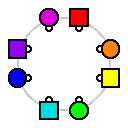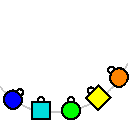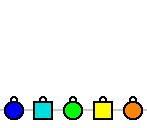Before calling, the caller will strategically choose couples in squares to be his/her key couples
and make note of their home positions.
After calling for a half a minute or so, the caller will begin to "resolve the square" by looking
for the key couples in the pilot square(s).
S/he will first want to observe how the key couples are positioned relative to each
other by looking for patterns.
Next s/he will call to rearrange the dancers and ultimately deliver the final calls that will
bring the dancers back home - hopefully without any hesitation so the dance experience is smooth
and the dancers are surprised when the final call comes!
The caller can watch only these 4 key dancers and more or less ignore the others for purposes of
resolving the square.
When it is time to resolve, the first thing the caller must do is locate the key
couples and see if they fit any recognized pattern the caller is familiar with.
The caller can then develop a strategy to move them around with respect to each other
and call a memorized "get-out" - a series of calls that the caller has memorized to
get from a known "setup" to the final call that gets them back home.
It is also possible to resolve the dancers "at home" by using only the key couples.
It almost goes without saying that a caller must recognize patterns.
The more patterns a caller can recognize, the easier resolving will be.
The most essential skill is to be able to "unwrap" the dancers in a formation to determine
if they are in the correct order.
This relates to how they were squared up at home.
and various arrangements and so on.
While these diagrams have easy-to-see colors and little dots to aid in seeing the patterns
it is quite another story to be able to see these patterns quickly and reliably in a real square,
especially if there are complicating factors.
To begin to see the variety of patterns that are possible see these articles...
As you read about each method below, consider how difficult it will be for you to relate key couples to each
other in all the various ways you'll encounter them in real formations.
Key Couple Relationships - Method Overviews
Once we have chosen 4 key dancers, we will need to be able to get them in the correct orientation
with respect to each other in order to resolve.
To assure this orientation, we need to make note of 3 relationships between our 4 dancers.
In other words, after we memorize who the 4 dancers are, we must also memorize
3 additional pieces of information to associate these dancers with each other.
This is where the various methods differ.
"Adjacent Couples and Corners" Method
This is the most widely used scheme and is the one taught in most caller schools.
- Partner relationship for couple #1
(i.e. these 2 folks are partners)
- Partner relationship for couple #2
- Corner relationship between the couples
(which 2 of these 4 dancers are each other's corners)
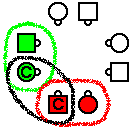
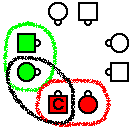
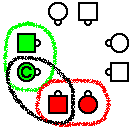
"Adjacent Couples and Sequence" Method
- Partner relationship for couple #1
(sometimes referred to as the "Primary Couple")
- Partner relationship for couple #2
(sometimes referred to as the "Secondary Couple")
- The sequence of the couples -
Note which couple should be in front of the other as they Promenade
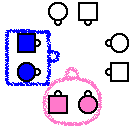
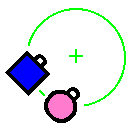
"Mental Snapshot" Method
- The visual pattern of all 4 dancers when they are in the correct order
The pattern would appear broken if any dancer was out of order
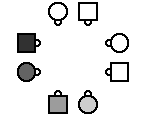

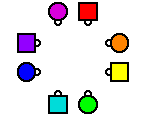
This method is the obvious choice if you have a photographic memory.
It may also be a good one to use if the dancers have some gradient of color
in their clothing, hair color, skin tone, height, etc.
Visualize the pattern that the correct sequence of dancers makes when they are squared
up at home and simply look for it when you call.
Only the correct sequence of dancers will make the correct pattern.
See "Mental Snapshot of the square" Method for a focused look this method.
"One Key Couple and Two Corners" Method
- Partner relationship for the primary couple
- The primary man's corner
- The primary lady's corner
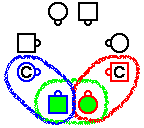
For some setups, most notably that needed for Dixie Grand, it is much easier
to see the patterns of the required setup with this method than with any of the others.
See "One Key Couple and Two Corners" Method for a focused look this method.
See Possible Pairings to test your ability to recognize the resolve
using the memorization scheme you've chosen.
Memorization Techniques
I find that simply remembering who the 4 key dancers are after I've been calling
a while is the single most difficult aspect of sight calling.
I will mention a few things I've noticed and make a few comments about this aspect of sight calling.
Things that make it easy....
People we naturally associate with each other are dancing together
Each couple is wearing matching clothing
The clothing is unique within the square
There are several squares for a better choice of easy-to-remember key couples
Our sight square has strong dancers that we can count on
Things that make it tough....
Squares we can see easily have weak dancers
Dancers are not dancing their biological gender
Dancers have nothing identifiable in common with their partner
Dancers with something identifiable in common are not partners
Dancers who danced together last tip are now dancing with different partners
Everyone is wearing a club uniform and looks exactly the same
Lighting is poor (e.g. demo tip in a night club with colored spot lights on the floor)
|
Look for similarities; Make associations
My advice: be politically incorrect.
If the square is difficult to memorize, use any device that will help.
Who's going to know?!
Look for outrageous similarities that will make an association you'll never forget.
Sound Memory
If you have a good auditory memory, perhaps you would do better by vocalizing
(to yourself) whatever association you've made.
Try saying all four dancers' names in order.
If not names, you could use physical characteristics, dress, or a mixture of all of these.
Chant to yourself the verbal association until you hear it as a familiar phrase.
If not 100% sure write 'em down
I've heard some callers say they never write down any key couple information.
I've heard other callers say they always write down key couple information,
including some that write down every one in the square, and in fact, every square in the hall.
You'll need to discover how much you can trust your own memory.
I find that after I've been calling a while, I get tired and have a much harder time remembering
key couples than I did in the first few tips.
I feel it is better to write the information down and never use it, than
to need it and not have it.
If you use politically incorrect mental mnemonics, be sure to destroy your notes after each tip!
| A pro's strategy from veteran caller Mike DeSisto
One day the dancers were already squared up. I watched Mike step up to the stage,
put a record on and immediately start calling.
After the tip I pulled him aside and asked him "How did you memorize the couples so quickly?"
His answer: He doesn't.
Mike will start calling memorized material.
At first, he calls whole memorized sequences (like an opener for example) and
watches the floor to see which squares look like ones he can depend on.
Next he'll call memorized modules.
At each point when everyone should be in the correct sequence, he'll look at a square and start memorizing.
He'll then call another module or so and look at the same square again.
When he feels confident with his ability to recall the order of couples in that square, he may start looking at another.
When the dancers have danced enough, he'll resolve (since he is calling memorized modules, he always knows the sequence for resolve.)
This process continues until he feels he can trust his memory and the pilot squares he's chosen then he moves to sight calling.
This process is completely invisible to the dancers
(and before he let me in on his secret, invisible to me!)
Now I observe many professional callers using similar techniques.
|
See Possible Pairings to test your ability to recognize the resolve
using the memorization scheme you've chosen.
See more of ALL8.com! - click here
Richard Reel Hayward California USA




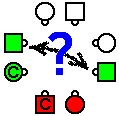 Unfortunately, this only works about half of the time unless we know something about the type of choreography that we've called all along
(see
Unfortunately, this only works about half of the time unless we know something about the type of choreography that we've called all along
(see 

